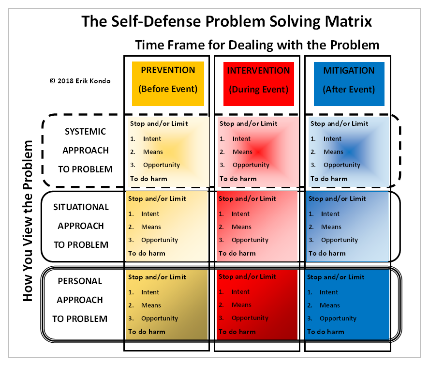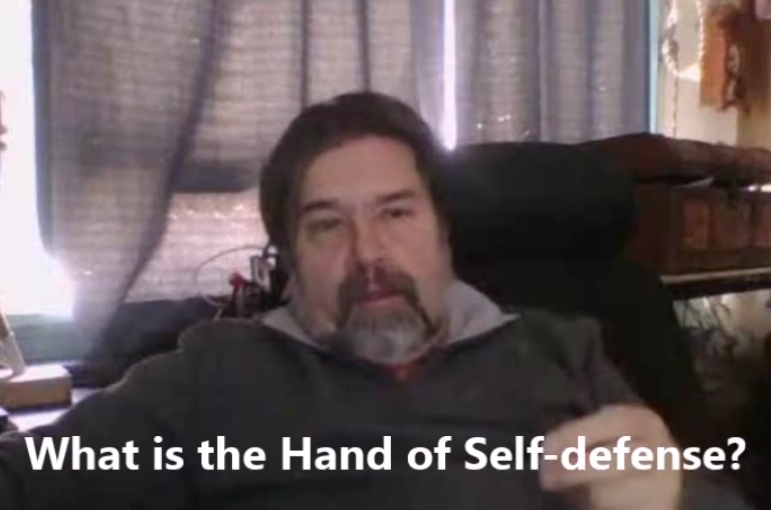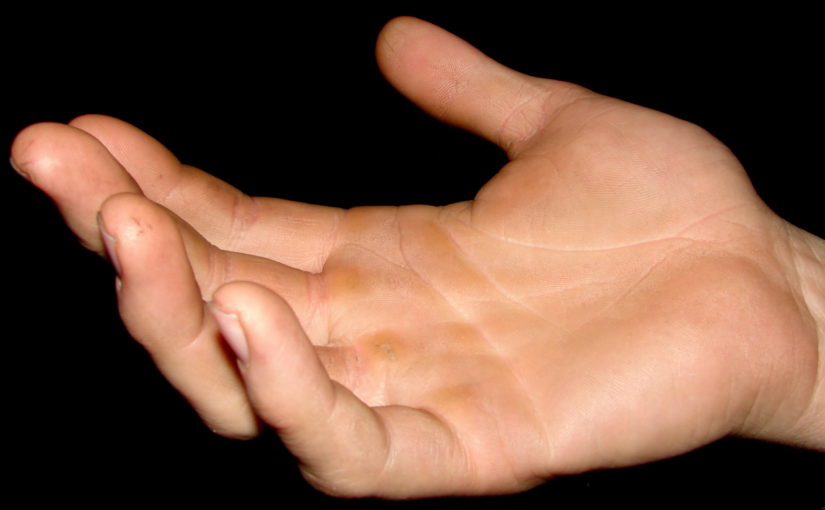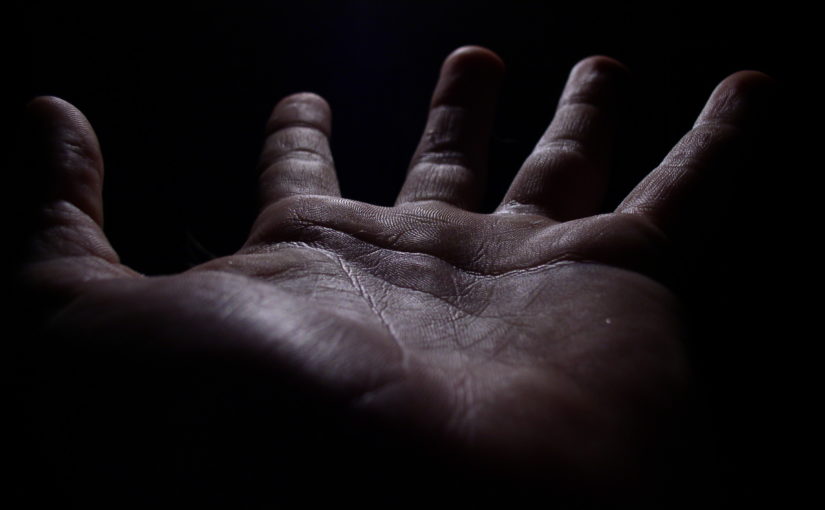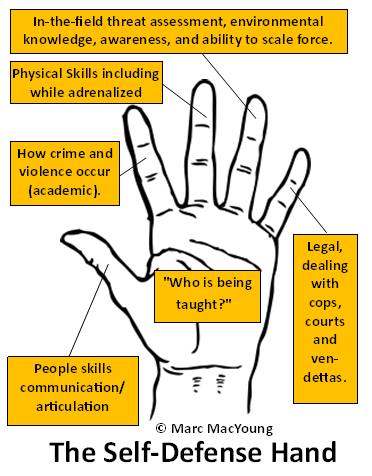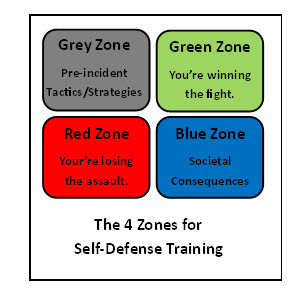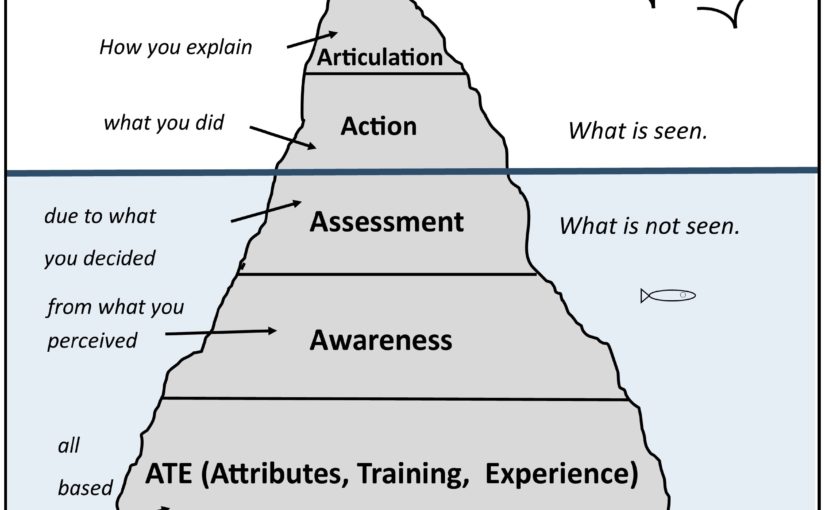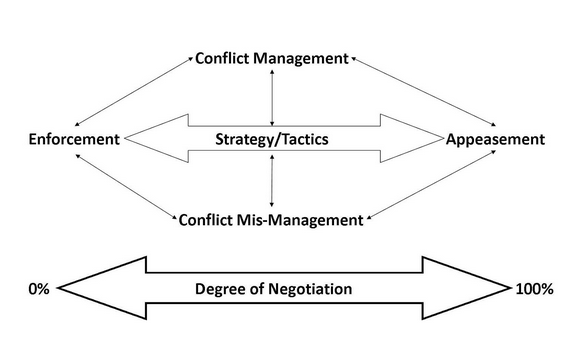The Self-Defense Hand:
Assessing if what-you-are-learning works for self-defense — and why you need to do it.
“Everyone knows what something means until there’s a problem”
Paul Spiegal
Contract Attorney
There’s a dangerous problem about both learning and teaching ‘self-defense.’ Mostly it’s about what you don’t know you don’t know.
It’s not hyperbole to say this lack will result with you in prison, the hospital, the morgue or financially destitute. (If not you, then your students.) Here’s the catch, it’s a problem that doesn’t reveal itself until you actually try to defend yourself. Think in terms of a plane with a crack in the wing you don’t see. While on the ground, nothing looks wrong and the problem doesn’t manifest. What’s going to happen if you try to fly that plane?
That’s why we’re going to have to spend some time identifying these hidden cracks before you’ll understand the fix. Starting with how many people don’t know what self-defense means.
“But, but I’m trained in self-defense I know what it means!”
Oh yeah? Is it a subject or an action? If it’s a subject, what’s involved? If it’s an action, what specific action and in what context? Let’s get something straight right now. You know what you’ve been taught as self-defense — usually in class. Another factor is what you have ‘researched’ and decided on your own. (I used the ‘ ‘ because much of the available material come from marketing spun sources.) Those are an understanding of the subject. That’s not the same as engaging in a violent situation with the appropriate level of force. Levels and actions to remain within the parameters of self-defense. Outside of the classroom, the range or the dojo self-defense is a little more … complicated
How do you use the term ‘self-defense?’ Is it a noun or verb? Many people think of it as a verb. It’s a type of action they think they’ll do. (Wait, self-defensing?) Yet, self-defense is in the dictionary as a noun. The subject of self-defense becomes an identifiable ‘thing’ — as in person, place or thing You learn self-defense. You acted in self-defense. But subjects tend to be complex. They involve lots of different things. However, your perspective changes if you think of it as a verb. Action is a whole lot simpler. All those pesky complexities disappear. In fact, you can start calling almost any action self-defense — and give yourself permission to do so. This regardless of whether they fit inside the parameters of the subject or not. When you don’t blur self-defense to allow become both a subject and an action, you clearly see a distinction between learning about and doing. There’s also a difference between knowing and doing. These are some of distinctions many people have lost.
That’s why we have to track it back to your root definition. Oh sure there’s the general verb/adjective definition. It runs along the lines of “defending myself from an attack.” But when you think about it, that’s actually kind of vague. Starting with, what do you mean by ‘attack?’ I ask because you’ll find folks sticking in caveats and spins. For example, “Self-defense is using my training to protect myself from physical and emotional attacks.”
Hang on there. Is someone using harsh language at you the same as slapping you? Is punching you the same as someone beating you? Is someone trying to punching the same as trying to shoot you? If the answer is ‘no,’ then using the same training as a blanket response is obviously a bad idea. If the answer is ‘well they’re all attacks’ (a qualified ‘yes’) you’re dangerously close to shooting someone for slapping you. (Or saying something that provokes someone to punch you.) Stated this way, it seems ridiculous. Obviously everyone knows that’s not what self-defense is. Okay, so what is self-defense then? And, more importantly, how do you apply it in the real world? What are some hard and fast standards you assess self-defense by?
Not so easy is it?
This goes beyond just ‘how much force do you use?’ It goes into what makes it self-defense (legal) vs. fighting, assault, manslaughter etc. (illegal). Just so you know, this is an area where subjective interpretation can really screw you up. It goes into when you stop using force (or cross into being the aggressor). Most people have no clear metrics or understanding about what legally constitutes self-defense, threat assessment, the sort of situation that requires it, how they can put themselves into or get out of such situations or be able to avoid excessive force. All of which have lots to do if what you do
- a) even works or
- b) if you’re going to be arrested later.
You’re in danger if you’ve never asked yourself, “Is what I’ve been taught really about self-defense?” This especially if what you’ve been taught has been mixed with sports, self-help or a social/political agenda. I recently had the unpleasant experience of talking to a women’s self-defense instructor who freely admitted she was relying on the man being arrested in any situation. That was why they didn’t include use of force limits or legal issues in what they taught women. Instead they encouraged women to go-all-out and told them it was all ‘self-defense.’ (Hint, you can knock him down, but you can’t jump up and down on his chest in your heels. The last isn’t self-defense.) Their instruction was predicated on the idea the police would always assume the woman to be the victim and arrest the man. (Rather disturbing version of ‘equality’ eh?)
With this in mind you need to ask is, “How do I assess if my response is self-defense?” Well, that brings us to the quality, expanse and — most of all — focus of your training. Because the answer to that question depends on if your training is teaching how to do it. Unfortunately, most of the time the answer is “No it isn’t.”
Let me explain that. You can spend a majority of your training time learning (in depth) a particular aspect, but that doesn’t mean you’re getting other — relevant — information about self-defense. (For example, all your tactical shooting training doesn’t teach you when to shoot.) Once you begin to search for some kind of standards about what is and what isn’t self-defense is all sorts of previously invisible information comes onto your radar. When that happens you realize ‘acting in self-defense’ is not as simple as you thought it was.
Let me give you an example of relevant information you’re not being taught about self-defense. Tell me: Where all these attackers you are training to handle are coming from? Well obviously, the simple answer is ‘They’re bad guys intent on hurting me.’
From an internal perspective that seems self-evident and obvious; except from an external standpoint it’s not that simple. Starting with how do you know you’re not aggressing on him? It’s not as black and white as you might think. Remember I used the word ‘subjective’ a little earlier? Here’s something that seriously influences it. A fellow by the name of Les Carter talks about the three core sources of anger
1) Preservation of essential needs.
2) Preservation of self-esteem and
3) Preservation of core beliefs.
While the manifestations are many, that mechanism is simple and pretty universal. You feel these are threatened, anger occurs and you act to < dramatic drum roll > defend yourself.
In case you missed it, that mechanism is the same for someone you call the ‘aggressor’ as it is for you ‘defending yourself.’ When you’re emotional, you think you’re defending yourself — even as you’re attacking. Spelling that out: When it comes to MOST violence, he thinks he’s doing exactly the same thing you think you’re doing; namely defending himself, except from you. And maybe he is because you’re so scared, hurt or angry, you are actually attacking.
That’s why it’s important to look at your actions from other than an internal perspective. You need to know if you are, in fact, aggressing against him while telling yourself it’s ‘self-defense.’ Believe me when I tell you crossing that line is a lot easier to do than you might think. Well, isn’t that awkward? Here’s the real unpleasant part, unless you know the ‘fingers’ I’m going to talk about in the next installment — and apply them — there’s a damned good chance, he’s partially correct.
Here’s the bad news, from an outside perspective you have him, any other witnesses testifying and possibly video of your participation in the creation and escalation of the conflict. That’s not self-defense. It’s a crime. In fact, this makes YOU the bad guy. Which if your so-called ‘self-defense’ training works, you’re going to get arrested. If it doesn’t work, you have other problems …
So what is self-defense? Where does the rubber hit the road with nuts-and-bolts standards, considerations, metrics and limits? This especially becomes important in doing it out in the real world. That’s where you can be put into prison or killed if you get it wrong. Now the really bad news. Odds are you were taught sets-you-up for those results. Largely, not because of what you were taught, but what you weren’t taught.
Remember when the answer to ‘what is self-defense’ had answers like “defending myself from an attack”? And why that’s not such a viable answer? (A more viable answer is “The appropriate level of force needed to keep you safe from an unprovoked attack,”)
Until now, that definition wouldn’t have made as much sense. So why is this so hard to understand? Two reasons.
One of the reasons is all the instructors out there who are peddling whatever it is they teach AS self-defense! Martial arts, mixed martial arts, knife fighting, shooting, empowerment, self-help, cardio and fitness … it’s all self-defense, doncha know?
No. No it’s not. But you won’t find that out until you’re getting arrested, or a fist crashes through your block and breaks your nose, or the back of your head is being jack-hammered off the concrete or you get jumped by six guys because you were ‘ready’ to fight only one. Wait, what? Is it really that bad? Yeah. In fact, it’s worse than you know. That’s why I’m writing these articles. Remember that fuzzy definition of self-defense?
Because it’s so vague, in the classroom/dojo/gym almost anything can be peddled as self-defense training. You wouldn’t believe some of the things I’ve heard instructors calling ‘self-defense.’ And they do.
When you come out and ask “Is what you’re teaching self-defense,” you will have people who insist it is — regardless of what they are teaching. You’ll usually find they’ve changed the definition of ‘self-defense’ to specifically mean what they are teaching. (This especially in self-help, empowerment training.) That’s why you need to have a better definition, other wise you’ll be sold a bill of goods. Or, going back to an earlier analogy you won’t know until you take off your wing is cracked.
If you press by asking ‘how is it self-defense,’ most often what you’ll get is “Well it’s not exactly self-defense, but it can be used for it!” Sure, and a cattle truck can be used to haul kids to soccer practice too. It’s just not as good as a mini-van for the job. Are they lying? Well no. It can be modified, but then the question is are they also teaching you how to modify it? To make it work, you’re going to have to tweak it differently for out in the street… or in the living room… or at a bar… or in a parking lot at two a.m. against multiple attackers. That’s allowing that it can be modified that much. That’s one hell of a big allowance.
Here’s where things can get a little … tricky. Often what is being taught by a particular source is exclusively a single aspect of self-defense, such as physical. This can be likened to a single finger on a hand, important, but not all there is to the subject of self-defense. Nor is the one aspect the key element of self-defense (e.g., all you need is the physical).
Nobody knows the whole of the subject of self-defense. And while we’re collecting ‘nopes,’ even allowing for specialization in one aspect, nobody knows all of that either. Pick a topic out of the aspect of physical. Any topic, shooting, empty hand or knife. You can learn a lot at a particular school. There will come a time when you’ve learned all that you can in that school, but that doesn’t mean you know all there is about the topic. That’s how big even these smaller topics are. I recently watched a SWAT team commander learn a new pistol grip from a female firearms instructor. The grip compensated for long fingernails. The man can shoot like nobody’s business, but acrylic nails wasn’t something he’d considered, much less had a solution to.
Another issue goes back to why I came up with the idea of the self-defense hand. That is often what is taught is small tidbits of different ‘fingers.’ There’s a lot of important information being left out. This is where things get really muddled. There are subjects that have relevance to self-defense, but that doesn’t make them self-defense. For example, there are certain people who have be convinced they are ‘worth’ defending themselves (a common issue among abuse survivors). But that does not automatically make ’empowerment training’ effective self-defense training — even if it does involve yelling, kicking and punching. But you can be damned sure it’s being sold as everything you need.
I really want to stress this point. It’s not that the information is wrong or doesn’t work. The problem isn’t that clear cut. It’s more that while what’s being taught will work in certain situations, what those situations are isn’t being taught. Or how to spot when it’s time to just turn and run fiercely. That’s because nothing you are trained in is going to work in those circumstances.
These are just a few of the issues involved with changing self-defense from a noun to a verb. The former is a subject to be taught. The latter is being able to do self-defense in the real world. Which brings us back to…
The second reason why ‘what is self-defense’ is complicated question is because of the real world answer. Not in the dojo answer. Not in the classroom answer. But one that has to do with your actions. Actions you will be held accountable for.
In application the most exact answer is “It depends.”
‘It depends’ comes closest to being the right answer because the question needs to be reframed as “Under different circumstances, what is both the appropriate level of force and stays within the boundaries of self-defense?”
That turns from a search for a simplistic answer to a subject of width, depth and understanding. (Which it just happens to be.) Realize violence comes in many different types, levels, variations and changing circumstances. Remember the “The appropriate level of force needed to keep you safe from an unprovoked attack” answer? Well what the appropriate level of force is depends on the circumstances of the situation. Circumstances you won’t be able to predict. Circumstances you can only asses on the spot. In other words, it depends.
Odds are, what you were taught as self-defense would work under certain conditions. But were you taught how to recognize when you’re in them? More importantly, recognize when you’re not? For example I knew a young black belt in a McDojo who down blocked into a knife. Great answer for an empty handed attack. In this case, the knife won. I tell you this because there is no one ‘answer,’ response or training system that covers every situation. Yet, odds are that’s what you’ve been sold or have bought into.
All of this has been aimed at understanding there’s an invisible crack in the wing of your airplane of self-defense. The last thing you want to have happen is discover the problem in the middle of a self-defense situation
End of Part I
